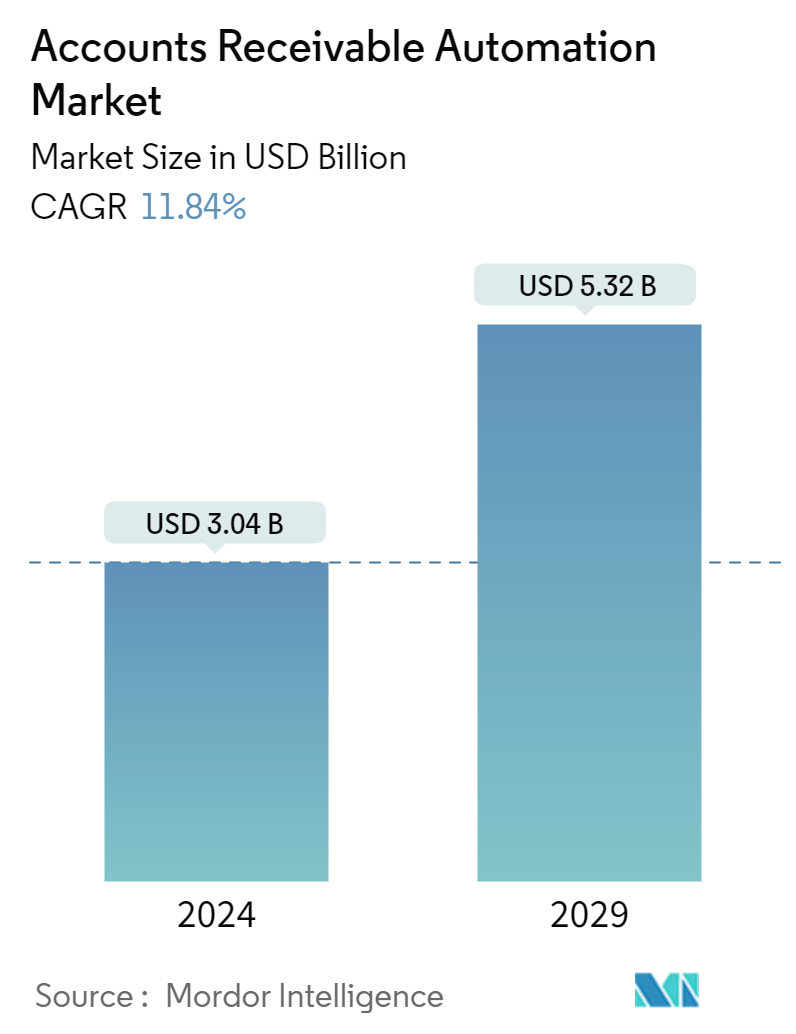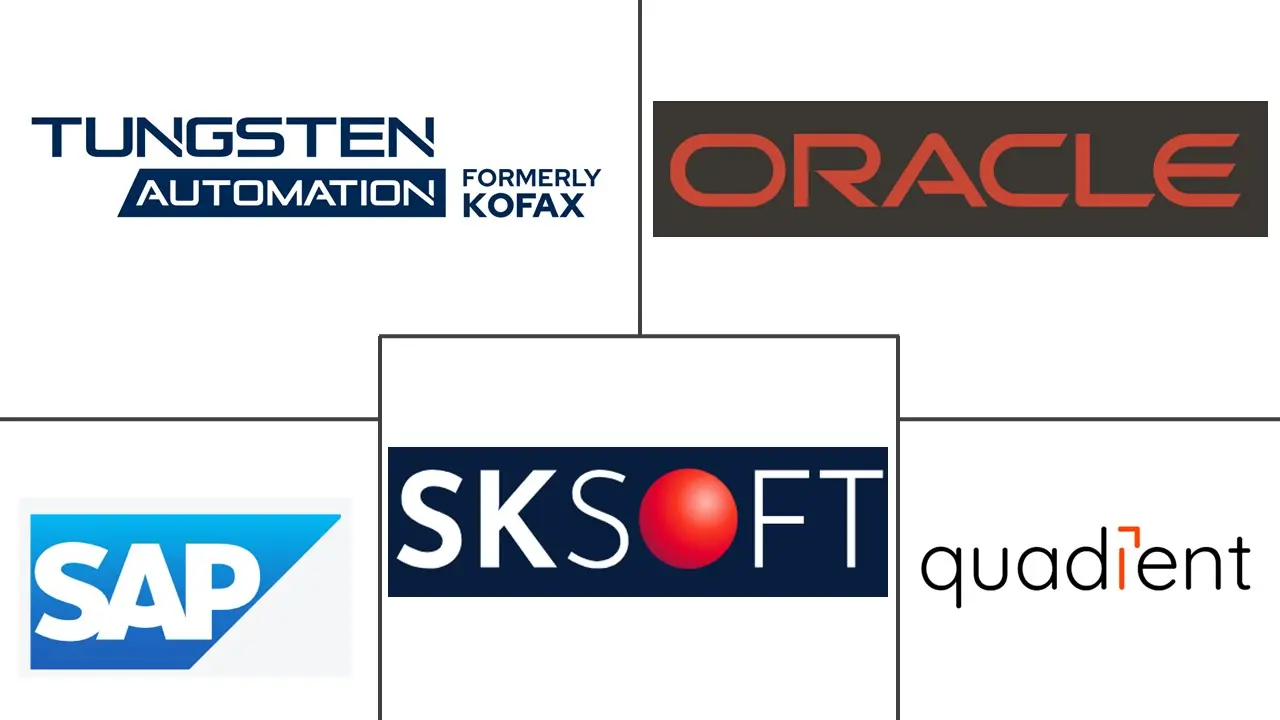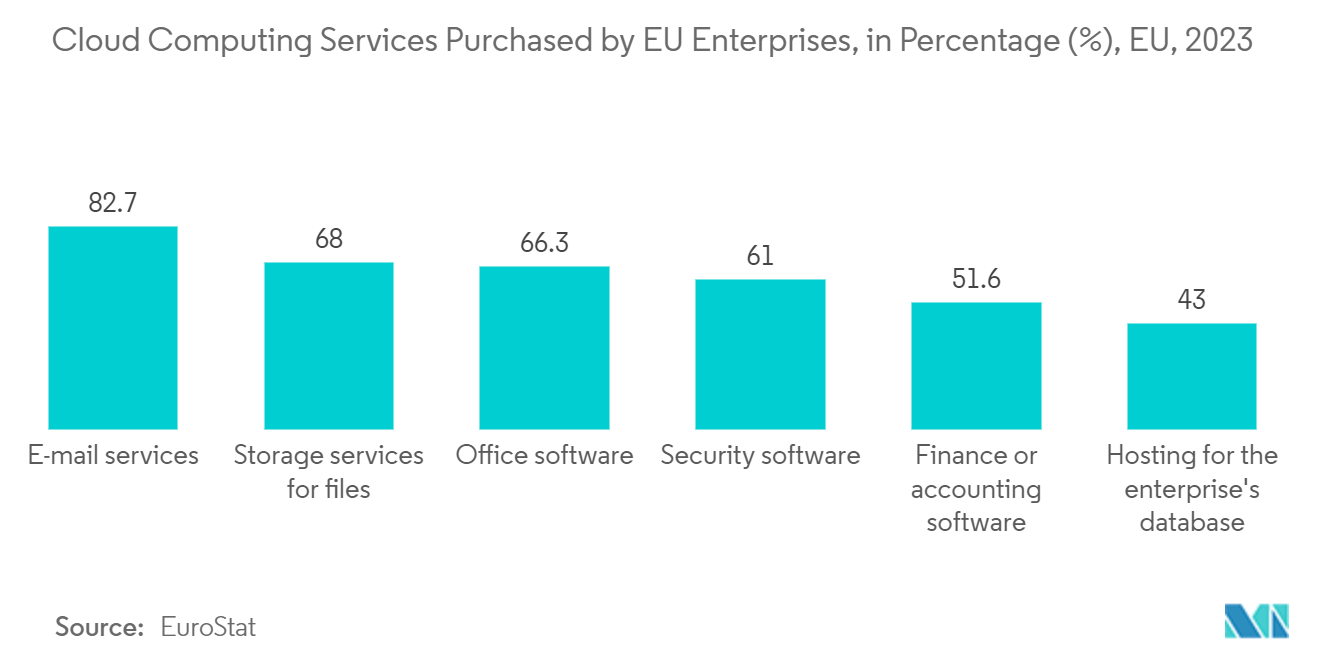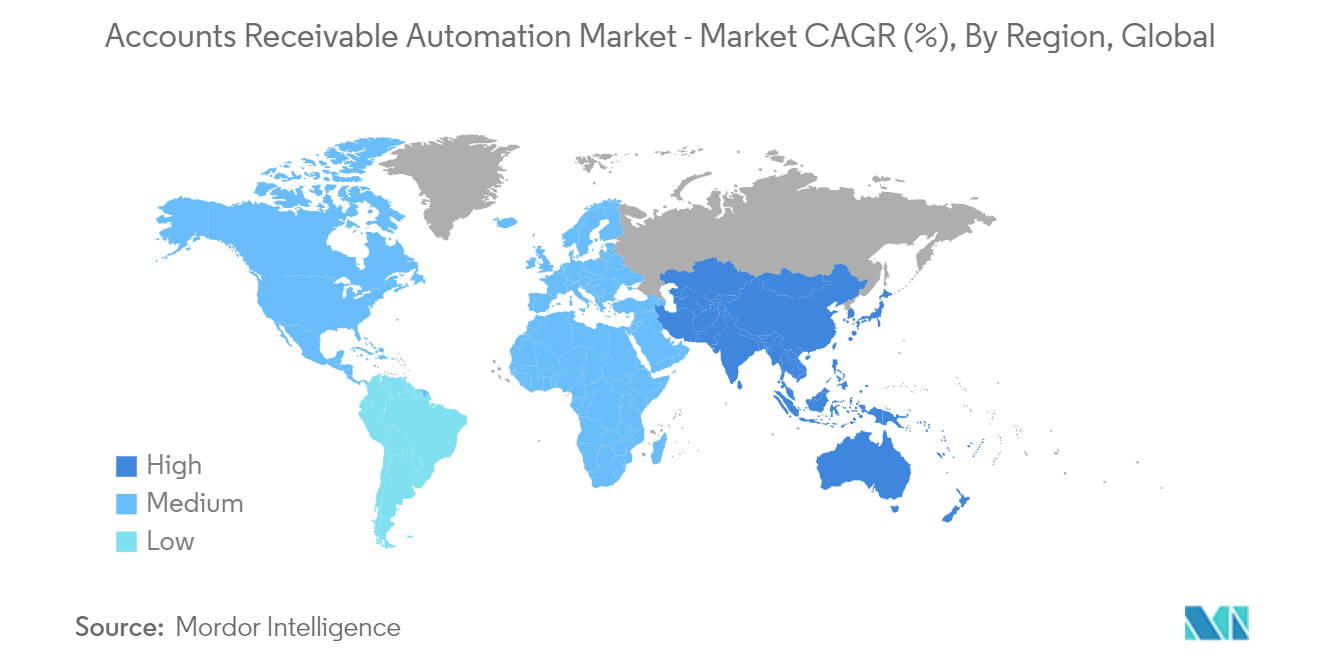AR Automation Market Size

| Study Period | 2019 - 2029 |
| Market Size (2024) | USD 3.04 Billion |
| Market Size (2029) | USD 5.32 Billion |
| CAGR (2024 - 2029) | 11.84 % |
| Fastest Growing Market | Asia-Pacific |
| Largest Market | North America |
Major Players
*Disclaimer: Major Players sorted in no particular order |
AR Automation Market Analysis
The Accounts Receivable Automation Market size is estimated at USD 3.04 billion in 2024, and is expected to reach USD 5.32 billion by 2029, growing at a CAGR of 11.84% during the forecast period (2024-2029).
- Efficiency Gains Drive Adoption of AR Automation: The Accounts Receivable Automation Market is witnessing rapid growth, primarily driven by the need for improved business efficiency, optimized cash flow, and cost reduction. Companies utilizing accounts receivable automation software have reported notable enhancements in both processing speed and team efficiency. For instance, a study by PYMNTS indicated that 87% of firms employing AR automation solutions can process invoices faster, while 79% experience increased team productivity. The cost advantage is also clear, as automated invoicing systems can generate electronic invoices for under USD 2, compared to up to USD 25 for paper invoices.
- Reduced DSO: AR automation has been shown to decrease Days Sales Outstanding (DSO) by as much as 30%, providing significant improvements in cash flow.
- Increased Processing Capacity: Automated systems can handle up to 19,000 invoices per month, compared to just 4,500 for manual processes.
- Quick Payback: 65% of companies report recouping their investment in AR workflow automation within 12 months, with this figure rising to 78% after 18 months.
- Cloud and AI Technologies Revolutionize AR Processes: The increasing adoption of cloud-based AR platforms and AI in accounts receivable is transforming the way businesses manage their accounts receivable functions. Cloud technology offers unmatched flexibility, scalability, and cost-efficiency, attracting businesses of all sizes. Cisco’s report predicts that 94% of all workloads will be processed in cloud data centers, with 75% of these workloads expected to be on Software-as-a-Service (SaaS) platforms by 2021.
- Cloud Adoption: 90% of companies have integrated some form of cloud service, which is crucial for digital payment processing in AR.
- AI Deployment: 34% of firms in the US, UK, and China are already using AI, demonstrating its growing role in automating AR functions.
- Speed and Accuracy: AI-powered payment reconciliation automation improves invoice processing speeds and accuracy, driving enhanced financial outcomes.
Market Dynamics and Future Outlook:
The market is seeing growing demand for accounts receivable management tools from both large corporations and SMEs. The need to reduce manual errors, ensure cash flow predictability, and improve customer experiences is pushing companies to adopt AR automation solutions. According to BlueSnap’s report, 93% of organizations face challenges with outdated AR processes, and 81% believe that late payments pose a risk to their business continuity.
- Delayed Payments Impact: On average, 27% of customers exceed their payment terms, leading to 30% of monthly revenue being tied up in accounts receivable.
- SME Challenges: SMEs face similar issues, with about 24% of monthly revenue held up in AR, highlighting the need for cash flow automation.
- Industry-Specific Growth: The healthcare sector is expected to experience a compound annual growth rate (CAGR) of 15.51% in AR automation adoption, underscoring the technology’s broad appeal.
Innovative Solutions and Market Players:
Key players in the market, such as HighRadius, Sage, and Esker, are innovating to provide financial automation technologies that streamline the entire order-to-cash cycle. These platforms not only automate invoice generation and payment matching but also integrate features such as accounts receivable analytics and predictive behavior models.
- Strategic Partnerships: HighRadius has teamed up with Sage to integrate RadiusOne A/R Suite with Sage Intacct, modernizing cloud-based AR operations.
- Advanced Features: Esker’s Cash Application solution optimizes the matching of invoices with received payments, boosting efficiency in the reconciliation process.
- AI Integration: Wells Fargo has developed automated collections management tools that leverage AI and machine learning for capturing payment and remittance data more effectively.
AR Automation Market Trends
Solutions Segment Driving Market Growth
The Solutions segment leads the accounts receivable automation market, capturing 84.78% of the total market share in 2021. This dominance is projected to grow, with the segment expected to reach USD 3.77 billion by 2027, at a CAGR of 12.70%.
- AI and ML Transformation: The use of AI in accounts receivable processes is revolutionizing the field, enhancing error detection, improving logic in payment matching, and reducing manual input in billing automation software.
- Cloud-Based Expansion: The shift to cloud-based AR platforms is accelerating the growth of the Solutions segment, especially among SMEs. The acquisition of Rimilia, an AI-driven AR automation firm, by Blackline for USD150 million highlights the demand for scalable cloud offerings.
- Efficiency Focus: Solutions that optimize cash flow and shorten accounting cycle times are a priority. Automation tools now enable AR teams to process large volumes of invoices faster, reducing the time spent on lower-value tasks like manual payment matching.
- Integration Capabilities: AR automation tools are increasingly valued for their ability to integrate with existing ERP systems, as seen in Esker’s acquisition of numberz and the launch of Chargebee Receivables.

Asia-Pacific Emerging as a High-Growth Region
The Asia-Pacific region is poised to become a global leader in AR automation, with a projected CAGR of 14.74% from 2023 to 2027. This growth is driven by rapid digital transformation across industries.
- SME-Led Growth: SMEs in Asia-Pacific are adopting AR automation to manage cash flow and improve operational efficiency. Aspire, a Singaporean AR automation provider, illustrates this trend, reaching USD 1 billion in transaction volume just one year after its launch.
- Strategic Expansions: Key players like Fuji Xerox are expanding their AR automation offerings in Asia-Pacific, reinforcing the region’s importance in the global market.
- Cloud and Mobile Growth: High smartphone penetration and a growing cloud infrastructure are fueling the adoption of mobile-first AR solutions, such as Bill.com’s $625 million acquisition of Invoice2go, aimed at expanding its presence in the region.
- Regulatory Compliance: Growing digital transaction regulations across Asia are driving AR automation adoption, as businesses seek to remain compliant while improving efficiency.

AR Automation Industry Overview
Global Players Dominate Consolidated Market
The Accounts Receivable Automation Market is dominated by global technology and financial service firms. Large enterprises such as SAP, Oracle, and Workday are leading the charge, while fintech innovators like HighRadius and Billtrust are introducing cutting-edge AR solutions tailored for businesses of all sizes. Consolidation in the market is reinforced by strategic partnerships and investments in AI, machine learning, and robotic process automation.
Technological Leadership: Established market players are focusing on developing robust, AI-driven accounts receivable management tools that offer superior automation capabilities and analytics.
Innovative Partnerships: HighRadius has expanded its collaboration with Commerce Bank to enhance AR automation processes, modernizing AR functions across different sectors.
Cloud-Based Dominance: Leaders in the market continue to prioritize cloud integration, with companies like SAP SE and Oracle focusing on scalable, AI-enhanced platforms for both SMEs and large enterprises.
Technology Giants and Fintech Innovators Lead: Major players include enterprise software providers like SAP SE and Oracle Corporation, alongside fintech companies like YayPay and Billtrust. The common theme among these leaders is their focus on cloud technology, accounts receivable process optimization, and seamless ERP integration.
Expansion into New Markets: Companies like Esker and HighRadius are rolling out AR automation solutions to address global demand, particularly in emerging markets like Asia-Pacific.
AI and Analytics Focus: Advanced AI-driven platforms like Esker’s Cash Application are gaining prominence, demonstrating the potential of predictive analytics in optimizing AR processes.
Adapting to Regulatory Demands: Companies are also tailoring solutions to meet local regulatory standards, exemplified by Apruve’s multilingual, localized invoicing tools designed for the Chinese market.
AR Automation Market Leaders
-
SAP SE
-
Oracle Corporation
-
SK Global Software
-
Quadient (YayPay Inc.)
-
Kofax Inc. (Tungsten Automation Corporation)
*Disclaimer: Major Players sorted in no particular order
-Automation-Market-Conc.webp)
AR Automation Market News
- August 2024 - Flywire acquires Invoiced, a cash flow management SaaS platform. Invoiced's solution automates Accounts Receivable processes, including payer communication, invoicing, and payment reconciliation with ERP systems.
- November 2023 - Quadient partners with Altares to integrate business decisioning data into its accounts receivable automation solution. The integration aims to enhance customer risk management and payment behavior assessment within Quadient's AR management platform.
- September 2023 - Esker partners with Boost Payment Solutions to automate virtual card processing for accounts receivable departments. The partnership integrates Esker's automation technology with Boost's straight-through processing solution to streamline virtual card acceptance and payment reconciliation.
AR Automation Market Report - Table of Contents
1. INTRODUCTION
- 1.1 Study Assumptions and Market Definition
- 1.2 Scope of the Study
2. RESEARCH METHODOLOGY
3. EXECUTIVE SUMMARY
4. MARKET INSIGHTS
- 4.1 Market Overview
-
4.2 Industry Attractiveness - Porter's Five Forces Analysis
- 4.2.1 Bargaining Power of Suppliers
- 4.2.2 Bargaining Power of Buyers
- 4.2.3 Threat of New Entrants
- 4.2.4 Threat of Substitutes
- 4.2.5 Intensity of Competitive Rivalry
- 4.3 Assessment of the Impact of COVID-19 on the Market
5. MARKET DYNAMICS
-
5.1 Market Drivers
- 5.1.1 Improve Business Efficiency by Improving Cash Flow and Reducing Costs and Accounting Cycle Time
- 5.1.2 Increasing Adoption of Technologies like Cloud Computing and AI
-
5.2 Market Restraints
- 5.2.1 Complex Procedure of Invoicing and Payment Management
- 5.2.2 Privacy and Security Concerns
6. MARKET SEGMENTATION
-
6.1 By Component
- 6.1.1 Solutions
- 6.1.2 Services
-
6.2 By Deployment Mode
- 6.2.1 On-premise
- 6.2.2 Cloud
-
6.3 By Size of the Organization
- 6.3.1 Small and Medium Enterprises
- 6.3.2 Large Enterprises
-
6.4 By End-user Industry
- 6.4.1 BFSI
- 6.4.2 IT and Telecom
- 6.4.3 Manufacturing
- 6.4.4 Healthcare
- 6.4.5 Transportation and Logistics
- 6.4.6 Other End-user Industries
-
6.5 By Geography***
- 6.5.1 North America
- 6.5.2 Europe
- 6.5.3 Asia
- 6.5.4 Australia and New Zealand
- 6.5.5 Latin America
- 6.5.6 Middle East and Africa
7. COMPETITIVE LANDSCAPE
-
7.1 Company Profiles*
- 7.1.1 SAP SE
- 7.1.2 Oracle Corporation
- 7.1.3 SK Global Software
- 7.1.4 Quadient (YayPay Inc.)
- 7.1.5 Kofax Inc.
- 7.1.6 Workday Inc.
- 7.1.7 Corcentric LLC
- 7.1.8 HighRadius Corporation
- 7.1.9 Qvalia AB
- 7.1.10 MHC Automation
- 7.1.11 Bill.com Holdings Inc.
- 7.1.12 Comarch SA
- 7.1.13 Esker Inc.
8. INVESTMENT ANALYSIS
9. MARKET OPPORTUNITIES AND FUTURE TRENDS
** Subject To AvailablityAR Automation Industry Segmentation
Accounts receivable automation is the modernization of the accounts receivable processes via electronic systems, which helps in reducing repetitive and time-consuming tasks. Automation helps free up the time for accounts receivable teams to focus on higher-value work by optimizing their schedules and reducing task dependencies.
The accounts receivable automation market is segmented by component (solutions and services), by deployment mode (on-premise and cloud), by size of the organization (small and medium enterprises and large enterprises), by end-user industry (BFSI, IT and telecom, manufacturing, healthcare, and transportation and logistics, other end-user industries), and by geography (North America, Europe, Asia Pacific, Latin America and Middle East and Africa). The report offers market forecasts and size in value (USD) for all the above segments.
| By Component | Solutions |
| Services | |
| By Deployment Mode | On-premise |
| Cloud | |
| By Size of the Organization | Small and Medium Enterprises |
| Large Enterprises | |
| By End-user Industry | BFSI |
| IT and Telecom | |
| Manufacturing | |
| Healthcare | |
| Transportation and Logistics | |
| Other End-user Industries | |
| By Geography*** | North America |
| Europe | |
| Asia | |
| Australia and New Zealand | |
| Latin America | |
| Middle East and Africa |
AR Automation Market Research FAQs
How big is the Accounts Receivable Automation Market?
The Accounts Receivable Automation Market size is expected to reach USD 3.04 billion in 2024 and grow at a CAGR of 11.84% to reach USD 5.32 billion by 2029.
What is the current Accounts Receivable Automation Market size?
In 2024, the Accounts Receivable Automation Market size is expected to reach USD 3.04 billion.
Who are the key players in Accounts Receivable Automation Market?
SAP SE, Oracle Corporation, SK Global Software, Quadient (YayPay Inc.) and Kofax Inc. (Tungsten Automation Corporation) are the major companies operating in the Accounts Receivable Automation Market.
Which is the fastest growing region in Accounts Receivable Automation Market?
Asia-Pacific is estimated to grow at the highest CAGR over the forecast period (2024-2029).
Which region has the biggest share in Accounts Receivable Automation Market?
In 2024, the North America accounts for the largest market share in Accounts Receivable Automation Market.
What years does this Accounts Receivable Automation Market cover, and what was the market size in 2023?
In 2023, the Accounts Receivable Automation Market size was estimated at USD 2.68 billion. The report covers the Accounts Receivable Automation Market historical market size for years: 2019, 2020, 2021, 2022 and 2023. The report also forecasts the Accounts Receivable Automation Market size for years: 2024, 2025, 2026, 2027, 2028 and 2029.
Accounts Receivable Automation Industry Report
Accounts Receivable Automation Market Research
Our comprehensive industry research in the accounts receivable automation market provides actionable insights into the latest trends, emerging technologies, and key market players driving transformation across sectors. The report covers in-depth analysis of market segmentation, industry trends, and regional growth patterns, offering stakeholders a detailed industry outlook and future market predictions. From cloud-based AR platforms to AI-driven financial automation technologies, the report provides a thorough understanding of how these advancements optimize accounts receivable processes for enhanced efficiency and cost-effectiveness.
The accounts receivable automation market report covers everything from market leaders and innovative solutions to the competitive landscape and industry growth drivers. Detailed market data, including sales trends, forecasts, and key statistics, is presented in an easy-to-read report pdf format. This report equips decision-makers with the essential industry information needed to capitalize on opportunities, improve operational workflows, and ensure compliance with evolving digital payment processing standards.



